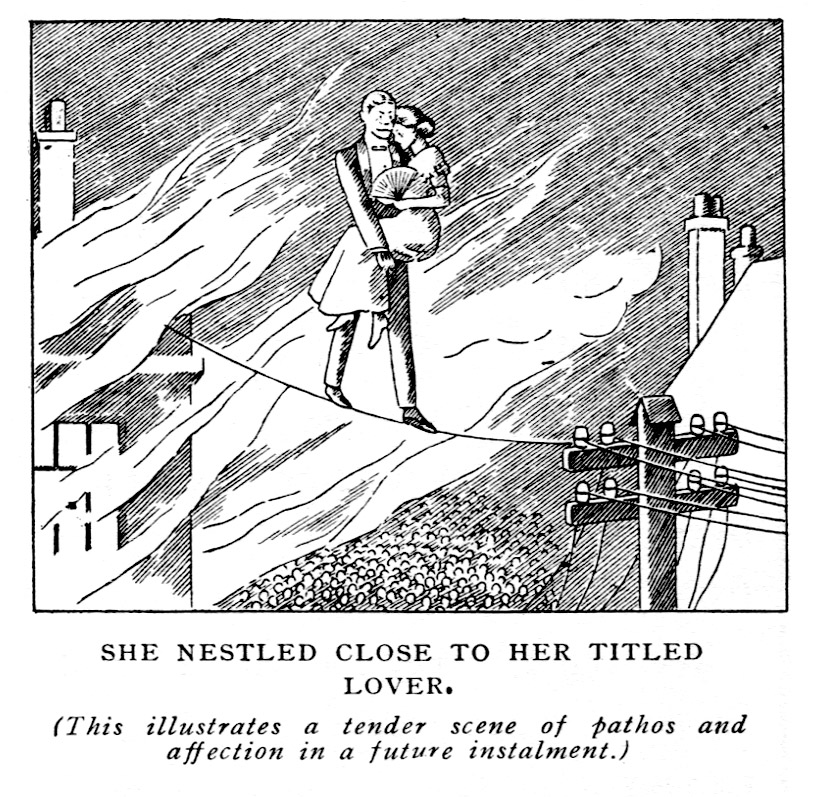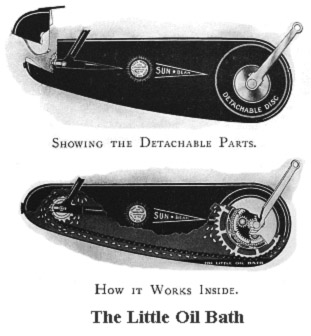Our Lightning Serial.
You Can Start Now.

AUTHOR OF “THE BLOOD THAT DRIPPED ON THE DOORMAT,”
“THE SCREAM IN
BELGRAVE SQUARE,” “THE VAMPIRE OF BODGER’S ALLEY.”
Synopsis of Previous
Chapters.—Viscount Lord Baldwin Berkeley, a reduced peer, who works
Jeapes’ Bioscope at Poole’s
Myriorama, The bioscope was
an early form of motion picture projector; I found one reference to a “Jeape”
in connection with early animated graphics, but was unable to locate any
further information. The moving panorama was an enormous painted canvas with contiguous views of passing
scenery, as if seen from a boat or a train window. Installed on immense spools,
they were scrolled past the audience behind a cut-out drop-scene or proscenium
which hid the mechanism from public view. In the early nineteenth century,
traveling panorama shows had been operated by several firms, notably that of
Moses Gompertz, who with his assistants the Poole brothers traveled the length
and breadth of Britain. His business was taken over by the Pooles in 1880. To
distinguish theirs from rival shows, they started to use the name Myriorama,
and by 1900 they had seven separate shows touring for 40 weeks of the year.
They added elaborate effects to the scrolling paint-and-cloth panoramas:
cut-out figures moving across the scene, accompanied by music, lighting and
sound effects. The narrator, often one of the Poole brothers in evening dress,
would describe and interpret. “Poole’s Myriorama” was well-known and
is even mentioned in James Joyce’s Ulysses.
The bioscope was
an early form of motion picture projector; I found one reference to a “Jeape”
in connection with early animated graphics, but was unable to locate any
further information. The moving panorama was an enormous painted canvas with contiguous views of passing
scenery, as if seen from a boat or a train window. Installed on immense spools,
they were scrolled past the audience behind a cut-out drop-scene or proscenium
which hid the mechanism from public view. In the early nineteenth century,
traveling panorama shows had been operated by several firms, notably that of
Moses Gompertz, who with his assistants the Poole brothers traveled the length
and breadth of Britain. His business was taken over by the Pooles in 1880. To
distinguish theirs from rival shows, they started to use the name Myriorama,
and by 1900 they had seven separate shows touring for 40 weeks of the year.
They added elaborate effects to the scrolling paint-and-cloth panoramas:
cut-out figures moving across the scene, accompanied by music, lighting and
sound effects. The narrator, often one of the Poole brothers in evening dress,
would describe and interpret. “Poole’s Myriorama” was well-known and
is even mentioned in James Joyce’s Ulysses.
is now in strict training as a fasting man in the family vault of
the Puce-Drortlands at BelweckWilliam John Cavendish-Bentinck-Scott was
5th Duke of Portland (1800–1879); his estate was named Welbeck Abbey. After his death in 1896 an application was made by the
widow of Walter Thomas Druce for his body to be exhumed from the Druce family vault at
Highgate Cemetery. (It became known as the Druce-Portlands case). She claimed that her
father-in-law T. C. Druce was in fact the 5th Duke of Portland, who had worked as an
upholsterer for some years then staged a sham burial as Druce in 1864. The coffin would,
therefore, be empty. The case to claim the Portland inheritance was continued by members
of the Druce family for some years after Mrs. Druce was admitted to a mental home in 1903.
The coffin was finally opened in 1907 and was found indeed to contain the body of
T. C. Druce.
, for
the love of Marjorie Stagg-Mantle, who, by
the will of an Australian uncle, can only marry a man who can go without food
for a hundred and fifteen years. These facts come to the ears of Luke
Lockhart, who is trying to press his claim to the Puce-Drortland estates. If
he can prove that the vault does not contain a corpse he can pay the blackmail
levied on him by the Countessa Maria Spaghetti, and at the same time work the
African gold mine which he has stolen from Sir Charles Claridge.

CHAPTER XLCMDDI.
The Vault at Midnight.
Nonogenarian Giles, the youngest
inhabitant of Belweck Village, said that the vault was haunted, and Lockhart,
who was in the four-ale bar of “The Testament and Codicil,” overheard him say
it. “Senile babblings,” he muttered, igniting a
Woodbine, Woodbine was a brand
of cigarette made in England noted for its strong unfiltered cigarettes. The
brand was popular in the early 20th century, especially with soldiers during
World War I.
Woodbine was a brand
of cigarette made in England noted for its strong unfiltered cigarettes. The
brand was popular in the early 20th century, especially with soldiers during
World War I.
“and yet it’s worth
while putting to the test.” . . . It was Sir Charles Claridge to whom
Mr. PlowdenAlfred Chichele Plowden (1844–1914) was presiding magistrate at the Marylebone Police Court from 1893; his pithy and ironic comments from the bench were widely quoted in newspapers, including the “By the Way” column.
observed,
with a laugh, that “Lockhart means to have the vault
opened, and by Jove, he’s made me sign the order. As the old saw has it,
‘Where there’s a will there’s a right of way.’ ”
Midnight boomed out in
thirteen booms from the clock tower of Belweck Castle. On the last stroke the
sinister form of Luke pedalled to the ivy-clad door of the silent vault. Leaning
his Sunbeam bicycle Sunbeam bicycle: Sunbeam bicycles
(Always ‘The Sunbeam’) were made in Wolverhampton from 1887 to 1937.
Sunbeam bicycle: Sunbeam bicycles
(Always ‘The Sunbeam’) were made in Wolverhampton from 1887 to 1937.
against a convenient tombstone, and hastily refreshing
himself by a plunge into the little oil bath From 1897 the chain and gears of Sunbeam bicycles were encased in an oil-filled housing called “The Little Oil Bath” in their advertising. [NM]
From 1897 the chain and gears of Sunbeam bicycles were encased in an oil-filled housing called “The Little Oil Bath” in their advertising. [NM]
, Luke called upon the officials of
Court to do their duty. His
King of the Road duplex lampJoseph Lucas called his best quality lamps “King of the Road.”
shone palely in
the brilliant moonlight.
“Give me the key,” said Mr. Plowden, smilingly stepping forward.
“Stand back,” commanded Marjorie, imperiously.
“You poltroon,a wretched coward [1520–30]
”
bellowed Claridge; “you have stolen my gold-mine.”
“Pay me the last instalment of my blackmail,” whispered the bitter-sweet accents of the Countessa.
“Ha, ha,” laughed Luke. “You cannot
foil me now,” and he beckoned to the
Legion of Frontiersmen, The Legion of
Frontiersmen were a patriotic
organisation formed in Britain in 1905 and designed to bolster the defensive
capacity of the British Empire. Prompted by pre-war fears of a pending invasion
of Britain, the organisation was founded on a romanticized conception of the
“frontier” and imperial idealism. Branches were formed throughout the
empire to prepare patriots for war and to foster vigilance in peacetime. The
Legion raised battalions and its members enlisted en masse at the onset
of the First World War. Wodehouse mentions the League in The Swoop! from
1909.
The Legion of
Frontiersmen were a patriotic
organisation formed in Britain in 1905 and designed to bolster the defensive
capacity of the British Empire. Prompted by pre-war fears of a pending invasion
of Britain, the organisation was founded on a romanticized conception of the
“frontier” and imperial idealism. Branches were formed throughout the
empire to prepare patriots for war and to foster vigilance in peacetime. The
Legion raised battalions and its members enlisted en masse at the onset
of the First World War. Wodehouse mentions the League in The Swoop! from
1909.
who waited in
ambush. “Remember La Milo,![]() La Milo: was an Australian vaudeville
performer named named Pansy Montague who specialized in creating “living statues.”
She reenacted Lady Godiva’s ride through Coventry in August 1907, clad in flesh-colored,
tight fitting apparel, much to the scandal of the countryside.
La Milo: was an Australian vaudeville
performer named named Pansy Montague who specialized in creating “living statues.”
She reenacted Lady Godiva’s ride through Coventry in August 1907, clad in flesh-colored,
tight fitting apparel, much to the scandal of the countryside.
” shouted Luke.
The Legion rallied with a cry of
“Coventry!”Scene of Lady Godiva’s ride; see La Milo above.
The door swung open.
“I am betrayed!” It was Lord Baldwin’s voice.
“There is no corpse here,” said Luke, with a snarl of triumph.
“You lie,” retorted Berkeley, “and you will be it, unless you leave the vault.”
Luke hesitated. “But the will,” he stammered.
“It is a forgery,” said Sir Charles; “read this.”
(To be continued.)
R E A D E R S !
This story is being closely revised by a special staff of fiction editors.
Over 5,000 assorted expletives have already been cut out.
No fewer than 637 descriptions of scenery have been removed. In the Trial for Murder Scene (see next instalment) the judge’s summing up was deleted almost as soon as it had been written.
The weather, you will notice, is practically ignored.
To realise how your interests have been protected, order this superb work of fiction IN BOOK FORM.
The first five editions have already been exhausted.
_______________
 Madame Eulalie’s Rare Plums
Madame Eulalie’s Rare Plums